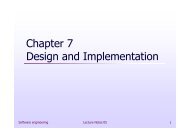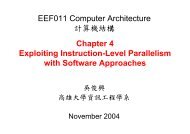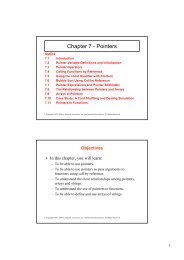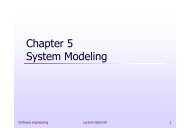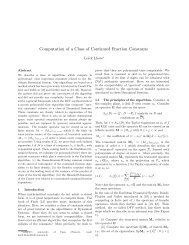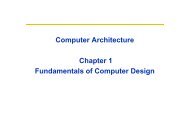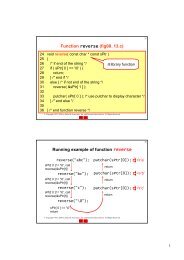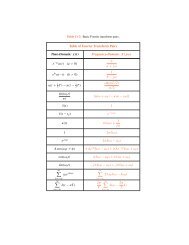C Programming (2)
C Programming (2)
C Programming (2)
Create successful ePaper yourself
Turn your PDF publications into a flip-book with our unique Google optimized e-Paper software.
Chapter 3 - Structured Program<br />
Development<br />
Outline<br />
3.1 Introduction<br />
3.2 Algorithms<br />
3.3 Pseudocode<br />
3.4 Control Structures<br />
3.5 The If Selection Statement<br />
3.6 The If…Else Selection Statement<br />
3.7 The While Repetition Statement<br />
3.8 Formulating Algorithms: Case Study 1 (Counter-Controlled<br />
Repetition)<br />
3.9 Formulating Algorithms with Top-down, Stepwise<br />
Refinement: Case Study 2 (Sentinel-Controlled Repetition)<br />
3.10 Formulating Algorithms with Top-down, Stepwise<br />
Refinement: Case Study 3 (Nested Control Structures)<br />
3.11 Assignment Operators<br />
3.12 Increment and Decrement Operators<br />
1<br />
3.1 Introduction<br />
•Before writing a program:<br />
–Have a thorough understanding of the problem<br />
–Carefully plan an approach for solving it<br />
•While writing a program:<br />
–Know what “building blocks”are available<br />
–Use good programming principles<br />
2<br />
1
3.2 Algorithms<br />
3<br />
•Computing problems<br />
–All can be solved by executing a series of actions in a<br />
specific order<br />
•Algorithm: procedure in terms of<br />
–Actions to be executed<br />
–The order in which these actions are to be executed<br />
•Program control<br />
–Specify order in which statements are to be executed<br />
3.3 Pseudocode<br />
•Pseudocode ( 虛 擬 碼 )<br />
–Artificial, informal language that helps us<br />
develop algorithms<br />
–Similar to everyday English<br />
–Not actually executed on computers<br />
–Helps us “think out”a program before writing it<br />
•Easy to convert into a corresponding C++ program<br />
•Consists only of executable statements<br />
4<br />
2
3.4 Control Structures:<br />
Sequential Execution<br />
5<br />
•Sequential execution<br />
–Statements executed one after the other in the<br />
order written<br />
6<br />
•Transfer of control<br />
Transfer of Control<br />
–When the next statement executed is not the next one in<br />
sequence<br />
–Overuse of goto statements led to many problems<br />
3
7<br />
Bohm and Jacopini<br />
•All programs written in terms of 3 control<br />
structures<br />
–Sequence structures: Built into C. Programs<br />
executed sequentially by default<br />
–Selection structures: C has three types: if,<br />
if…else, and switch<br />
–Repetition structures: C has three types: while,<br />
do…while and for<br />
8<br />
•Flowchart ( 流 程 圖 )<br />
Flowchart<br />
–Graphical representation of an algorithm<br />
–Drawn using certain special-purpose symbols<br />
connected by arrows called flowlines<br />
–Rectangle symbol (action symbol):<br />
•Indicates any type of action<br />
–Oval symbol:<br />
•Indicates the beginning or end of a program<br />
or a section of code<br />
4
9<br />
Single-Entry/Single-Exit<br />
•Single-entry/single-exit control structures<br />
–Connect exit point of one control structure to<br />
entry point of the next (control-structure<br />
stacking)<br />
–Makes programs easy to build<br />
10<br />
3.5 The if Selection Statement<br />
•Selection structure:<br />
–Used to choose among alternative courses of action<br />
–Pseudocode:<br />
If student’s grade is greater than or equal to 60<br />
Print “Passed”<br />
–If condition true<br />
•Print statement executed and program goes on to next<br />
statement<br />
–If false, print statement is ignored and the program goes<br />
onto the next statement<br />
–Indenting makes programs easier to read<br />
•C ignores whitespace characters<br />
5
11<br />
3.5 The if Selection Statement<br />
• Pseudocode statement in C:<br />
if ( grade >= 60 )<br />
printf( "Passed\n" );<br />
–C code corresponds closely to the pseudocode<br />
• Diamond symbol (decision symbol) in flow chart<br />
–Contains an expression that can be true or false<br />
–Test the condition, follow appropriate path<br />
grade >= 60<br />
false<br />
decision to<br />
be made<br />
true<br />
print “Passed”<br />
single entry/single exit<br />
A decision can be made<br />
on any expression.<br />
zero - false<br />
nonzero - true<br />
Example:<br />
3 - 4 is true<br />
12<br />
練 習 一<br />
• 設 計 一 段 程 式 , 要 求 使 用 者 輸 入 一 個 整 數 , 當<br />
此 整 數 為 7 時 輸 出 “Bingo!”。<br />
• 提 示 : 使 用 if 敘 述 。<br />
• 注 意 :C 語 言 中 如 何 測 試 數 值 的 相 等 ?<br />
• 保 留 此 程 式 供 下 個 練 習 用 。<br />
6
3.6 The if…else Selection Statement<br />
13<br />
•if<br />
–Only performs an action if the condition is true<br />
•if…else<br />
–Specifies an action to be performed both when the<br />
condition is true and when it is false<br />
•Psuedocode:<br />
If student’s grade is greater than or equal to 60<br />
Print “Passed”<br />
else<br />
Print “Failed”<br />
–Note spacing/indentation conventions<br />
The if…else Selection Statement in C<br />
14<br />
•C code:<br />
if ( grade >= 60 )<br />
printf( "Passed\n");<br />
else<br />
printf( "Failed\n");<br />
flowchart<br />
single entry/single exit<br />
false<br />
grade >= 60<br />
true<br />
print<br />
“Failed”<br />
print<br />
“Passed”<br />
7
15<br />
練 習 二<br />
• 設 計 一 段 程 式 , 要 求 使 用 者 輸 入 一 個 整 數 , 當<br />
此 整 數 為 7 時 輸 出 “Bingo!”, 否 則 輸 出 “Bad<br />
luck.”<br />
• 提 示 : 使 用 if…else 敘 述 。<br />
• 保 留 此 程 式 供 下 個 練 習 用 。<br />
16<br />
Ternary Condition Operator (?:)<br />
•Ternary conditional operator (?:)<br />
–Takes three arguments (condition, value if true,<br />
value if false)<br />
–Our pseudocode could be written:<br />
printf( "%s\n", grade >= 60 ? "Passed" :<br />
"Failed" );<br />
–Or it could have been written:<br />
grade >= 60 ? printf( “Passed\n” ) :<br />
printf( “Failed\n” );<br />
8
17<br />
Nested if…else Selection Statement<br />
•Nested if…else statements<br />
–Test for multiple cases by placing if…else selection<br />
statements inside if…else selection statement<br />
If student’s grade is greater than or equal to 90<br />
Print “A”<br />
else<br />
If student’s grade is greater than or equal to 80<br />
Print “B”<br />
else<br />
If student’s grade is greater than or equal to 70<br />
Print “C”<br />
else<br />
If student’s grade is greater than or equal to 60<br />
Print “D”<br />
else<br />
Print “F”<br />
Deep indentation<br />
usually not used<br />
in practice<br />
18<br />
練 習 三<br />
• 設 計 一 段 程 式 , 要 求 使 用 者 輸 入 一 個 整 數 , 當<br />
此 整 數 為 7 或 11 時 輸 出 “Bingo!”, 否 則 輸 出<br />
“Bad luck.”<br />
• 提 示 : 使 用 nested if…else 敘 述 。<br />
• 保 留 此 程 式 供 下 個 練 習 用 。<br />
9
19<br />
•Compound statement:<br />
Compound Statement<br />
–Set of statements within a pair of braces<br />
–Example:<br />
if ( grade >= 60 )<br />
printf( "Passed.\n" );<br />
else {<br />
printf( "Failed.\n" );<br />
printf( "You must take this course<br />
again.\n" );<br />
}<br />
–Without the braces, the statement<br />
printf( "You must take this course<br />
again.\n" );<br />
would be executed automatically<br />
20<br />
Block and Errors<br />
•Block:<br />
–Compound statements with declarations<br />
•Syntax errors ( 語 法 錯 誤 )<br />
–Caught by compiler<br />
•Logic errors ( 邏 輯 錯 誤 ):<br />
–Have their effect at execution time<br />
–Non-fatal: program runs, but has incorrect<br />
output<br />
–Fatal: program exits prematurely<br />
10
3.7 The while Repetition Statement<br />
•Repetition structure<br />
–Programmer specifies an action to be repeated<br />
while some condition remains true<br />
–Psuedocode:<br />
21<br />
While there are more items on my shopping list<br />
Purchase next item and cross it off my list<br />
–while loop repeated until condition becomes<br />
false<br />
The while Repetition Statement<br />
22<br />
•Example:<br />
int product = 2;<br />
while ( product
23<br />
練 習 四<br />
• 設 計 一 段 程 式 , 要 求 使 用 者 輸 入 一 個 整 數 。<br />
• 當 此 整 數 不 為 7 的 倍 數 時 即 輸 出 “Incorrect, try<br />
again.” 並 要 求 使 用 者 再 次 輸 入 , 直 到 使 用 者<br />
輸 入 7 的 倍 數 為 止 。<br />
• 當 使 用 者 輸 入 7 的 倍 數 時 輸 出 “Bingo!”。<br />
• 提 示 : 使 用 while 敘 述 。<br />
• 測 試 時 考 慮 第 一 次 就 輸 入 7 的 情 形 、 第 二 次 才<br />
輸 入 7 的 情 形 、 以 及 第 三 次 才 輸 入 7 的 情 形 等 。<br />
3.8 Formulating Algorithms<br />
(Counter-Controlled Repetition)<br />
•Counter-controlled repetition<br />
–Loop repeated until counter reaches a certain value<br />
–Definite repetition: number of repetitions is known<br />
–Example: A class of ten students took a quiz. The grades<br />
(integers in the range 0 to 100) for this quiz are available to<br />
you. Determine the class average on the quiz<br />
–Pseudocode:<br />
24<br />
Set total to zero<br />
Set grade counter to one<br />
While grade counter is less than or equal to ten<br />
Input the next grade<br />
Add the grade into the total<br />
Add one to the grade counter<br />
Set the class average to the total divided by ten<br />
Print the class average<br />
12
fig03_06.c (1/2)<br />
6 int main()<br />
7 {<br />
8 int counter; /* number of grade to be entered next */<br />
9 int grade; /* grade value */<br />
10 int total; /* sum of grades input by user */<br />
11 int average; /* average of grades */<br />
12<br />
13 /* initialization phase */<br />
14 total = 0; /* initialize total */<br />
15 counter = 1; /* initialize loop counter */<br />
17 /* processing phase */<br />
18 while ( counter
27<br />
練 習 五<br />
• 設 計 一 段 程 式 , 輸 出 所 有 1 至 100 的 整 數 。<br />
• 提 示 : 使 用 while 敘 述 。<br />
• 保 留 此 程 式 供 下 個 練 習 用 。<br />
練 習 六<br />
• 設 計 一 段 程 式 , 輸 出 1 至 100 中 可 被 7 整 除 的 整<br />
數 。<br />
• 提 示 : 使 用 while 及 if 敘 述 。<br />
• 保 留 此 程 式 供 下 個 練 習 用 。<br />
3.9 Formulating Algorithms with Top-<br />
Down, Stepwise Refinement<br />
•Problem becomes:<br />
Develop a class-averaging program that will process<br />
an arbitrary number of grades each time the program<br />
is run.<br />
–Unknown number of students<br />
–How will the program know to end?<br />
•Use sentinel value<br />
–Also called signal value, dummy value, or flag value<br />
–Indicates “end of data entry.”<br />
–Loop ends when user inputs the sentinel value<br />
–Sentinel value chosen so it cannot be confused with a<br />
regular input (such as -1 in this case)<br />
28<br />
14
29<br />
Top-Down, Stepwise Refinement<br />
•Top-down, stepwise refinement<br />
–Begin with a pseudocode representation of the top:<br />
Determine the class average for the quiz<br />
–Divide top into smaller tasks and list them in order:<br />
Initialize variables<br />
Input, sum and count the quiz grades<br />
Calculate and print the class average<br />
•Many programs have three phases:<br />
–Initialization: initializes the program variables<br />
–Processing: inputs data values and adjusts program variables<br />
accordingly<br />
–Termination: calculates and prints the final results<br />
30<br />
Stepwise Refinements (1/2)<br />
•Refine the initialization phase from Initialize<br />
variables to:<br />
Initialize total to zero<br />
Initialize counter to zero<br />
•Refine Input, sum and count the quiz grades to<br />
Input the first grade (possibly the sentinel)<br />
While the user has not as yet entered the sentinel<br />
Add this grade into the running total<br />
Add one to the grade counter<br />
Input the next grade (possibly the sentinel)<br />
15
Stepwise Refinements (2/2)<br />
31<br />
•Refine Calculate and print the class average to<br />
If the counter is not equal to zero<br />
Set the average to the total divided by the counter<br />
Print the average<br />
else<br />
Print “No grades were entered”<br />
Final Pseudocodes<br />
32<br />
Initialize total to zero<br />
Initialize counter to zero<br />
Input the first grade<br />
While the user has not as yet entered the sentinel<br />
Add this grade into the running total<br />
Add one to the grade counter<br />
Input the next grade (possibly the sentinel)<br />
If the counter is not equal to zero<br />
Set the average to the total divided by the counter<br />
Print the average<br />
else<br />
Print “No grades were entered”<br />
16
fig03_08.c (1/2)<br />
本 範 例 請 在 課 後 研 讀<br />
6 int main()<br />
7 {<br />
8 int counter; /* number of grades entered */<br />
variable<br />
9 int grade; /* grade value */<br />
definitions<br />
10 int total; /* sum of grades */<br />
12 float average; /* number with decimal point for average */<br />
13<br />
15 total = 0; /* initialize total */<br />
variable<br />
16 counter = 0; /* initialize loop counter */<br />
initialization<br />
18 /* processing phase */<br />
19 /* get first grade from user */<br />
20 printf( "Enter grade, -1 to end: " ); /* prompt for input */<br />
21 scanf( "%d", &grade ); /* read grade from user */<br />
23 /* loop while sentinel value not yet read from user */<br />
24 while ( grade != -1 ) {<br />
25 total = total + grade; /* add grade to total */<br />
© 26 Copyright 1992–2004 counter by Deitel = & counter Associates, Inc. + 1; and Pearson Education /* Inc. increment All Rights Reserved. counter */<br />
33<br />
fig03_08.c (2/2)<br />
34<br />
28 printf( "Enter grade, -1 to end: " ); /* prompt for input */<br />
29 scanf("%d", &grade); /* read next grade */<br />
30 } /* end while */<br />
32 /* termination phase */<br />
33 /* if user entered at least one grade */<br />
34 if ( counter != 0 ) {<br />
36 /* calculate average of all grades entered */<br />
37 average = ( float ) total / counter;<br />
39 /* display average with two digits of precision */<br />
40 printf( "Class average is %.2f\n", average );<br />
41 } /* end if */<br />
42 else { /* if no grades were entered, output message */<br />
43 printf( "No grades were entered\n" );<br />
44 } /* end else */<br />
46 return 0; /* indicate program ended successfully */<br />
48 } /* end function main */<br />
© Copyright 1992–2004 by Deitel & Associates, Inc. and Pearson Education Inc. All Rights Reserved.<br />
17
Enter grade, -1 to end: 75<br />
Enter grade, -1 to end: 94<br />
Enter grade, -1 to end: 97<br />
Enter grade, -1 to end: 88<br />
Enter grade, -1 to end: 70<br />
Enter grade, -1 to end: 64<br />
Enter grade, -1 to end: 83<br />
Enter grade, -1 to end: 89<br />
Enter grade, -1 to end: -1<br />
Class average is 82.50<br />
sentinel<br />
Program Output<br />
35<br />
Enter grade, -1 to end: -1<br />
No grades were entered<br />
sentinel<br />
© Copyright 1992–2004 by Deitel & Associates, Inc. and Pearson Education Inc. All Rights Reserved.<br />
36<br />
•Problem<br />
3.10 Nested control structures<br />
–A college has a list of test results (1 = pass, 2 = fail) for 10<br />
students<br />
–Write a program that analyzes the results<br />
•If more than 8 students pass, print "Raise Tuition"<br />
•Notice that<br />
–The program must process 10 test results<br />
•Counter-controlled loop will be used<br />
–Two counters can be used<br />
•One for number of passes, one for number of fails<br />
–Each test result is a number—either a 1 or a 2<br />
•If the number is not a 1, we assume that it is a 2<br />
18
37<br />
•Top level outline<br />
Pseudocodes<br />
Analyze exam results and decide if tuition should be raised<br />
•First Refinement<br />
Initialize variables<br />
Input the ten quiz grades and count passes and failures<br />
Print a summary of the exam results and decide if tuition<br />
should be raised<br />
•Refine Initialize variables to<br />
Initialize passes to zero<br />
Initialize failures to zero<br />
Initialize student counter to one<br />
38<br />
Refinements<br />
• Refine Input the ten quiz grades and count passes and<br />
failures to<br />
While student counter is less than or equal to ten<br />
Input the next exam result<br />
If the student passed<br />
Add one to passes<br />
else<br />
Add one to failures<br />
Add one to student counter<br />
• Refine Print a summary of the exam results and decide if<br />
tuition should be raised to<br />
Print the number of passes<br />
Print the number of failures<br />
If more than eight students passed<br />
Print “Raise tuition”<br />
19
Final Pseudocodes<br />
39<br />
Initialize passes to zero<br />
Initialize failures to zero<br />
Initialize student to one<br />
While student counter is less than or equal to ten<br />
Input the next exam result<br />
If the student passed<br />
Add one to passes<br />
else<br />
Add one to failures<br />
Add one to student counter<br />
Print the number of passes<br />
Print the number of failures<br />
If more than eight students passed<br />
Print “Raise tuition”<br />
fig03_10.c (1/2)<br />
6 int main()<br />
7 {<br />
8 /* initialize variables in definitions */<br />
9 int passes = 0; /* number of passes */<br />
10 int failures = 0; /* number of failures */<br />
variable definitions<br />
and initializations<br />
11 int student = 1; /* student counter */<br />
12 int result; /* one exam result */<br />
13<br />
14 /* process 10 students using counter-controlled loop */<br />
15 while ( student
fig03_10.c (2/2)<br />
41<br />
25 else { /* otherwise, increment failures */<br />
26 failures = failures + 1;<br />
27 } /* end else */<br />
29 student = student + 1; /* increment student counter */<br />
30 } /* end while */<br />
32 /* termination phase; display number of passes and failures */<br />
33 printf( "Passed %d\n", passes );<br />
34 printf( "Failed %d\n", failures );<br />
36 /* if more than eight students passed, print "raise tuition" */<br />
37 if ( passes > 8 ) {<br />
38 printf( "Raise tuition\n" );<br />
39 } /* end if */<br />
41 return 0; /* indicate program ended successfully */<br />
43 } /* end function main */<br />
© Copyright 1992–2004 by Deitel & Associates, Inc. and Pearson Education Inc. All Rights Reserved.<br />
Enter Result (1=pass,2=fail): 1<br />
Enter Result (1=pass,2=fail): 2<br />
Enter Result (1=pass,2=fail): 2<br />
Enter Result (1=pass,2=fail): 1<br />
Enter Result (1=pass,2=fail): 1<br />
Enter Result (1=pass,2=fail): 1<br />
Enter Result (1=pass,2=fail): 2<br />
Enter Result (1=pass,2=fail): 1<br />
Enter Result (1=pass,2=fail): 1<br />
Enter Result (1=pass,2=fail): 2<br />
Passed 6<br />
Failed 4<br />
Program Output<br />
42<br />
Enter Result (1=pass,2=fail): 1<br />
Enter Result (1=pass,2=fail): 1<br />
Enter Result (1=pass,2=fail): 1<br />
Enter Result (1=pass,2=fail): 2<br />
Enter Result (1=pass,2=fail): 1<br />
Enter Result (1=pass,2=fail): 1<br />
Enter Result (1=pass,2=fail): 1<br />
Enter Result (1=pass,2=fail): 1<br />
Enter Result (1=pass,2=fail): 1<br />
Enter Result (1=pass,2=fail): 1<br />
Passed 9<br />
Failed 1<br />
Raise tuition<br />
© Copyright 1992–2004 by Deitel & Associates, Inc. and Pearson Education Inc. All Rights Reserved.<br />
21
43<br />
練 習 七<br />
• 設 計 一 段 程 式 , 計 算 1 至 100 中 可 被 7 整 除 的 數<br />
字 共 有 多 少 個 。 輸 出 此 結 果 。<br />
• 提 示 : 利 用 一 個 變 數 累 計 次 數 。<br />
• 保 留 此 程 式 供 下 個 練 習 用 。<br />
練 習 八<br />
• 設 計 一 段 程 式 , 計 算 1 至 100 中 可 被 7 整 除 的 數<br />
字 總 和 是 多 少 。 輸 出 此 結 果 。<br />
• 提 示 : 利 用 一 個 變 數 累 計 總 和 值 。<br />
• 保 留 此 程 式 供 下 個 練 習 用 。<br />
44<br />
3.11 Assignment Operators<br />
•Assignment operators abbreviate assignment<br />
expressions<br />
c = c + 3;<br />
can be abbreviated as c += 3; using the addition<br />
assignment operator<br />
•Statements of the form<br />
variable = variable operator expression;<br />
can be rewritten as<br />
variable operator= expression;<br />
22
Arithmetic Assignment Operators<br />
45<br />
• Examples of other assignment operators:<br />
d -= 4 (d = d - 4)<br />
e *= 5 (e = e * 5)<br />
f /= 3 (f = f / 3)<br />
g %= 9 (g = g % 9)<br />
Assume: int c = 3, d = 5, e = 4, f = 6, g = 12;<br />
Assignment Sample Explanation Assigns<br />
operator expression<br />
+= c += 7 c = c + 7 10 to c<br />
-= d -= 4 d = d - 4 1 to d<br />
*= e *= 5 e = e * 5 20 to e<br />
/= f /= 3 f = f / 3 2 to f<br />
%= g %= 9 g = g % 9 3 to g<br />
3.12 Increment and Decrement Operators<br />
46<br />
•Increment operator (++)<br />
–Can be used instead of c+=1<br />
•Decrement operator (--)<br />
–Can be used instead of c-=1<br />
•Preincrement<br />
–Operator is used before the variable (++c or --c)<br />
–Variable is changed before the expression it is in is<br />
evaluated<br />
•Postincrement<br />
–Operator is used after the variable (c++ or c--)<br />
–Expression executes before the variable is changed<br />
23
3.12 Increment and Decrement Operators<br />
47<br />
•If c equals 5, then<br />
printf( "%d", ++c );<br />
–Prints 6<br />
printf( "%d", c++ );<br />
–Prints 5<br />
–In either case, c now has the value of 6<br />
•When variable not in an expression<br />
–Preincrementing and postincrementing have the same effect<br />
++c;<br />
printf( “%d”, c );<br />
–Has the same effect as<br />
c++;<br />
printf( “%d”, c );<br />
3.12 Increment and Decrement Operators<br />
48<br />
Operator Sample Explanation<br />
expression<br />
++ ++a Increment a by 1 then use the new<br />
value of a in the expression in<br />
which a resides.<br />
++ a++ Use the current value of a in the<br />
expression in which a resides, then<br />
increment a by 1.<br />
-- --b Decrement b by 1 then use the new<br />
value of b in the expression in<br />
which b resides.<br />
-- b-- Use the current value of b in the<br />
expression in which b resides, then<br />
decrement b by 1.<br />
24
fig03_13.c<br />
49<br />
3 #include <br />
5 /* function main begins program execution */<br />
6 int main()<br />
7 {<br />
8 int c; /* define variable */<br />
10 /* demonstrate postincrement */<br />
11 c = 5; /* assign 5 to c */<br />
12 printf( "%d\n", c ); /* print 5 */<br />
13 printf( "%d\n", c++ ); /* print 5 then postincrement */<br />
14 printf( "%d\n\n", c ); /* print 6 */<br />
16 /* demonstrate preincrement */<br />
17 c = 5; /* assign 5 to c */<br />
18 printf( "%d\n", c ); /* print 5 */<br />
19 printf( "%d\n", ++c ); /* preincrement then print 6 */<br />
20 printf( "%d\n", c ); /* print 6 */<br />
22 return 0; /* indicate program ended successfully */<br />
24 } /* end function main */<br />
© Copyright 1992–2004 by Deitel & Associates, Inc. and Pearson Education Inc. All Rights Reserved.<br />
5<br />
5<br />
6<br />
Program Output<br />
50<br />
5<br />
6<br />
6<br />
© Copyright 1992–2004 by Deitel & Associates, Inc. and Pearson Education Inc. All Rights Reserved.<br />
25
51<br />
練 習 九<br />
• 設 計 一 段 程 式 , 計 算 1 至 100 中 可 被 7 整 除 的 數<br />
字 共 有 多 少 個 。 輸 出 此 結 果 。<br />
• 提 示 : 利 用 ++ 運 算 子 來 累 計 次 數 。<br />
練 習 十<br />
• 設 計 一 段 程 式 , 計 算 1 至 100 中 可 被 7 整 除 的 數<br />
字 總 和 是 多 少 。 輸 出 此 結 果 。<br />
• 提 示 : 利 用 += 運 算 子 來 累 計 總 和 值 。<br />
Precedence of Operators so Far<br />
52<br />
Operators<br />
Associativity Type<br />
++ -- + - (type) right to left unary<br />
* / % left to right multiplicative<br />
+ - left to right additive<br />
< >= left to right relational<br />
== != left to right equality<br />
?: right to left conditional<br />
= += -= *= /= right to left assignment<br />
26
53<br />
練 習 十 一<br />
• 設 計 一 段 程 式 , 要 求 使 用 者 輸 入 一 個 整 數 N,<br />
輸 出 所 有 介 於 1 與 N 間 ( 不 大 於 N) 的 所 有 除 以 6 餘<br />
4 的 數 字 , 並 輸 出 這 樣 的 數 字 有 多 少 個 。<br />
• 提 示 1: 使 用 while 敘 述 。<br />
• 提 示 2: % 運 算 子 可 以 取 餘 數 。<br />
• 保 留 此 程 式 供 下 個 練 習 用 。<br />
54<br />
練 習 十 二<br />
• 設 計 一 段 程 式 , 要 求 使 用 者 輸 入 一 個 整 數 N,<br />
輸 出 下 列 運 算 的 結 果 :<br />
1<br />
1<br />
1<br />
<br />
2<br />
<br />
<br />
1<br />
N<br />
• 提 示 : 使 用 while 敘 述 。<br />
27
練 習 十 三<br />
55<br />
• 寫 一 個 C 程 式 , 讓 使 用 者 一 次 輸 入 一 個 整 數 ( 輸<br />
入 前 先 印 出 訊 息 提 示 使 用 者 這 是 第 幾 個 輸 入 的<br />
數 字 ) 。 使 用 者 可 輸 入 0 至 100 間 的 數 字 。 輸 入 -<br />
1 表 結 束 輸 入 。 輸 入 數 字 個 數 可 為 1 或 多 個 。 由<br />
程 式 輸 出 使 用 者 輸 入 數 字 中 最 大 與 最 小 的 。<br />
執 行 範 例<br />
Input number # 1: 50<br />
Input number # 2: 18<br />
黑 色 字 體 是 輸 出<br />
紅 色 字 體 是 輸 入<br />
Input number # 3: 98<br />
Input number # 4: 28<br />
Input number # 5: -1<br />
The largest number is 98<br />
The smallest number is 18<br />
28




